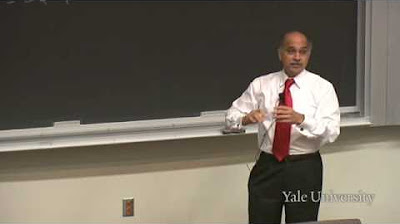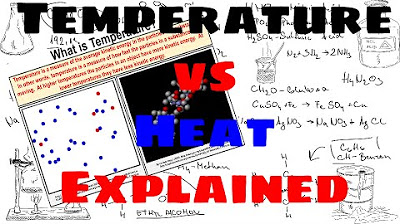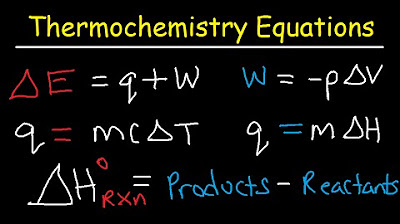21. Thermodynamics
TLDRIn this comprehensive lecture, Professor Ramamurti Shankar delves into the principles of thermodynamics, focusing on the concepts of temperature, heat transfer, and thermal equilibrium. He begins by defining temperature and thermal equilibrium, using the example of hot and cold water to illustrate the point. The professor then explains the zeroth law of thermodynamics, which establishes a global measure for temperature comparison. He further discusses the challenges in measuring temperature, the limitations of water's boiling and freezing points as standards, and introduces the Kelvin scale as an absolute temperature scale. The lecture continues with an exploration of heat as energy, its measurement in calories, and the concept of specific heat. Shankar also touches on latent heat during phase changes and the different modes of heat transfer, including radiation, convection, and conduction. The professor concludes with a historical perspective on the evolution of understanding heat as a form of energy, linking it to the kinetic energy of atoms and the conservation of energy principle. This lecture provides a foundational understanding of thermodynamics, emphasizing the importance of precision and the scientific method in advancing knowledge in the field.
Takeaways
- 📚 Professor Shankar introduces a new topic on thermodynamics, emphasizing the study of heat, temperature, and heat transfer.
- 🔍 The class discusses the intuitive definition of temperature and the concept of thermal equilibrium, using the example of hot and cold water in isolated cups.
- ⚖️ The zeroth law of thermodynamics is explained, which allows for the comparison of temperatures between two systems that have not interacted directly but have both been in equilibrium with a third system.
- 🌡️ The process of defining temperature units and the creation of thermometers is detailed, highlighting the historical use of water's freezing and boiling points as references.
- 🔑 The importance of the gas thermometer and its linear relationship between pressure and volume (PV) is discussed, showing how it leads to a more universally accepted temperature measurement.
- ❄️ The concept of absolute zero is introduced as the lowest possible temperature, where the product of gas pressure and volume (PV) goes to zero.
- 🔥 The specific heat capacity of materials is explained, showing how it varies between different substances and affects the amount of heat required to change their temperature.
- 💧 The phenomenon of latent heat is discussed, particularly in the context of phase changes such as melting and vaporization, where heat energy is used to change the state of a substance without changing its temperature.
- 🚿 An example is given to illustrate how to calculate the final state of a system involving ice and water at different temperatures when combined, considering the conservation of energy.
- ☀️ Different modes of heat transfer are described: radiation, which does not require a medium; convection, which involves the movement of the medium itself; and conduction, which depends on the material's thermal conductivity.
- 🔧 The Joule experiment is summarized, demonstrating the conversion between mechanical energy and heat, and establishing the relationship between joules and calories.
Q & A
What is the concept of thermodynamic equilibrium?
-Thermodynamic equilibrium is a state in which a system's macroscopic properties, such as temperature, do not change over time. It is a condition where the system is isolated from the outside world and maintains a constant temperature, not exchanging heat with the surroundings.
Why is the zeroth law of thermodynamics significant?
-The zeroth law of thermodynamics is significant because it allows for the establishment of a temperature scale. It states that if two systems are each in thermal equilibrium with a third, they are in thermal equilibrium with each other, enabling the comparison of temperatures between different systems.
How is the temperature measured using a gas thermometer?
-A gas thermometer measures temperature by observing the relationship between the pressure and volume of a gas. When the product of pressure and volume (PV) is plotted against temperature, it forms a straight line. The temperature is then determined by the position of the gas on this line relative to known fixed points, such as the freezing and boiling points of water.
What is the absolute zero of temperature?
-The absolute zero of temperature is the lowest possible temperature, where the kinetic energy of particles in a system is minimal. It is equivalent to -273.16 degrees Celsius or 0 Kelvin and represents the point at which the product of pressure and volume in a gas thermometer goes to zero.
How is heat transferred through radiation?
-Heat is transferred through radiation by electromagnetic waves. This mode of heat transfer does not require a medium and can occur through a vacuum, such as the heat from the Sun reaching Earth.
What is the difference between conduction and convection?
-Conduction is the transfer of heat through a solid material without the movement of the material itself, while convection involves the transfer of heat by the movement of fluids (liquids or gases). In convection, heated fluid expands, becomes less dense, and rises, while cooler, denser fluid sinks, creating a circulating current.
What is the role of specific heat capacity in the process of heating a substance?
-The specific heat capacity is a property of a material that determines how much heat is required to change the temperature of a given mass of the substance by a certain amount. It is used to calculate the amount of heat absorbed or released during a temperature change and varies for different materials.
What is latent heat and why is it important in phase changes?
-Latent heat is the amount of heat absorbed or released by a substance during a phase change (such as melting, freezing, vaporizing, or condensing) without changing its temperature. It is important because it explains why a substance can absorb or release a significant amount of heat without a change in temperature during phase transitions.
How does the Joule experiment demonstrate the conservation of energy?
-The Joule experiment demonstrates the conservation of energy by showing that the mechanical energy lost when a weight falls and turns a paddle in a container of water is converted into heat energy. The increase in the water's temperature, which can be measured in calories, corresponds to the mechanical energy expended, proving that energy is neither created nor destroyed but only transformed.
What is the relationship between calories and joules, and how is it determined?
-The relationship between calories and joules is one of energy equivalence. One calorie is equivalent to 4.2 joules. This conversion factor is determined through experiments like the Joule experiment, which show that a certain amount of mechanical energy (measured in joules) results in a corresponding amount of heat energy (measured in calories).
Why is thermal conductivity important in materials science?
-Thermal conductivity is important in materials science because it determines a material's ability to conduct heat. It is a crucial property for designing and engineering materials for various applications, such as heat sinks, insulators, or materials that require efficient heat transfer.
Outlines
😀 Introduction to Thermodynamics and Equilibrium
Professor Shankar begins by informing the class about the upcoming schedule changes for problem sets and introduces a new topic in thermodynamics. He discusses the intuitive understanding of temperature and the concept of thermodynamic equilibrium, using the example of hot and cold water reaching a state where they maintain a constant temperature when isolated from external influences.
🔍 Zeroth Law of Thermodynamics and Quantitative Temperature
The professor explains the zeroth law of thermodynamics, which allows for a global comparison of temperature between two systems that have not interacted directly but have interacted with a third system. He then delves into the quantitative aspects of temperature, discussing the use of a meter stick and liquids to measure temperature changes and the creation of a thermometer.
🌡️ Thermometers and the Celsius Scale
Shankar describes the construction of thermometers, highlighting the use of liquids like mercury or alcohol and the magnification of their volume expansion. He explains the establishment of the Celsius scale using the freezing and boiling points of water as fixed points, and the division of the temperature range between these points into equal parts to define degrees.
🔍 The Limitations of Water as a Temperature Standard
The professor discusses the unreliability of water's boiling point as a temperature standard due to changes in boiling points at different altitudes. He introduces the concept of gas thermometers, which provide a more consistent and universally applicable method for measuring temperature.
📉 Absolute Zero and the Kelvin Scale
Shankar explains that all gas thermometers indicate a special temperature at which the product of pressure and volume vanishes, which is defined as absolute zero. He discusses the Kelvin scale, which is an absolute temperature scale where the zero point is set at absolute zero, and the triple point of water is used to define one other temperature for the scale.
🔥 Heat and the Concept of Caloric Fluid
The professor introduces the concept of heat, denoted by Q, and the historical understanding of heat as the flow of a caloric fluid from hot to cold objects. He also explains the definition of a calorie in the context of heating a quantity of water and how this definition extends to other materials through the concept of specific heat.
🌡️ Specific Heat and the Coefficients of Expansion
Shankar discusses the concept of specific heat and how it varies with different materials, introducing the idea of the specific heat as a property of the material. He also touches on the concepts of linear and volume expansion, and how these are related to the material's properties, including the coefficient of linear expansion and the coefficient of volume expansion.
🔥 Heat Transfer and the Postulate of Energy Conservation
The professor explains the process of heat transfer when a heated material is introduced into a body of water, leading to a common final temperature. He introduces the postulate of energy conservation in the context of heat transfer, stating that the total change in heat energy (∆Q) is zero, meaning the heat lost by one body is equal to the heat gained by another.
🧊 Phase Changes and Latent Heat
Shankar discusses phase changes, such as the melting of ice and the transition from water to steam, and introduces the concept of latent heat, which is the heat required to change the state of a substance without changing its temperature. He explains how the specific heat capacities of ice and water differ and how to calculate the final states when given a certain amount of heat added to a system.
🌞 Modes of Heat Transfer: Conduction, Convection, and Radiation
The professor outlines the three primary modes of heat transfer: radiation, which does not require a medium; convection, which involves the movement of the medium itself; and conduction, which is the focus of the lecture and involves the flow of heat through a material due to a temperature difference. He emphasizes the role of the cross-section, temperature difference, and material properties in heat conduction.
🔧 The Joule Experiment and the Mechanical Equivalent of Heat
Shankar describes the Joule experiment, which demonstrates the conversion of mechanical energy into heat. He explains how the mechanical energy lost during inelastic collisions or the dropping of a weight is translated into heat energy, and introduces the conversion factor of 4.2 joules per calorie, reinforcing the idea that heat is a form of energy.
🔬 The Atomic Theory and Kinetic Energy as Heat
The professor concludes by hinting at the atomic theory, suggesting that the kinetic energy of atoms is what we perceive as heat. He differentiates between the macroscopic motion of objects and the microscopic motion of atoms within those objects, indicating that the latter is the source of heat energy.
Mindmap
Keywords
💡Thermodynamic equilibrium
💡Temperature
💡Zeroth law of thermodynamics
💡Thermometer
💡Calorie
💡Specific heat capacity
💡Latent heat
💡Heat transfer
💡Conduction
💡Thermal conductivity
💡Joule's experiment
Highlights
Professor Shankar introduces a new topic on thermodynamics, emphasizing the importance of precision in defining concepts like temperature and thermal equilibrium.
The zeroth law of thermodynamics is explained as a fundamental principle allowing for global comparison of temperature between systems.
The concept of thermal equilibrium is illustrated with the example of a cup of hot water, highlighting the system's macroscopic properties when isolated.
The use of liquids and gases in thermometers is discussed, with a focus on the advantages of gas thermometers for defining temperature scales.
The absolute zero of temperature is introduced as a concept derived from the behavior of gases, indicating the lowest possible temperature.
The triple point of water is described as a unique condition used to define a fixed point on the Kelvin temperature scale.
Heat is denoted by the symbol Q, and its transfer from hotter to cooler objects is explained through the concept of caloric fluid.
The specific heat capacity is defined as a material property that determines how much heat is required to change the temperature of a substance.
The principle of conservation of heat (∆Q = 0) is introduced as a fundamental rule for solving heat exchange problems.
The phenomenon of latent heat is discussed, explaining the amount of heat required to change the state of a substance without changing its temperature.
Different methods of heat transfer are outlined: radiation, convection, and conduction, each with distinct mechanisms and applications.
The thermal conductivity (κ) of a material is emphasized as a key factor in determining the rate of heat conduction.
The Joule experiment is summarized, demonstrating the conversion of mechanical energy into heat, and establishing a relationship between joules and calories.
The atomic theory of heat is briefly mentioned, suggesting that heat is a form of kinetic energy associated with the random motion of atoms and molecules.
The Law of Conservation of Energy is reinforced, showing that heat can be considered as a form of energy without violating this fundamental principle.
Practical applications of thermodynamics in understanding the behavior of materials under different temperature conditions are discussed.
Transcripts
Browse More Related Video

Thermal Physics (AP Physics SuperCram Review)

22. The Boltzmann Constant and First Law of Thermodynamics

23. The Second Law of Thermodynamics and Carnot's Engine

Temperature vs Heat - Explained

The Physics of Heat: Crash Course Physics #22

Thermochemistry Equations & Formulas - Lecture Review & Practice Problems
5.0 / 5 (0 votes)
Thanks for rating: